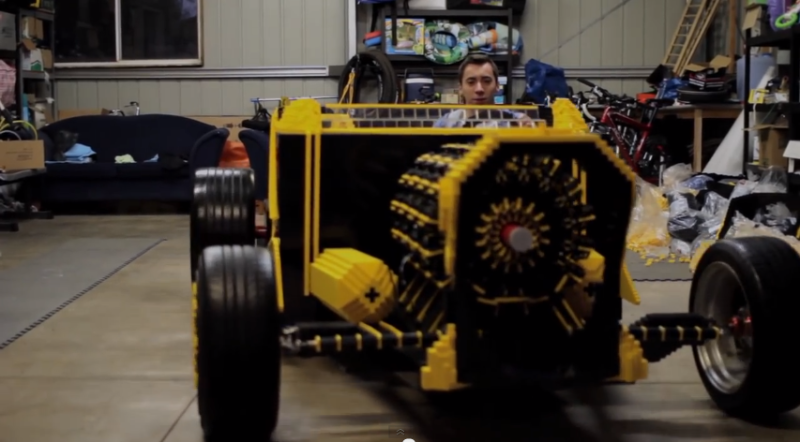[Steve Sammartino] is a Melbourne entrepreneur, and he had an idea: could it be possible to design and make a functional full-size Lego car?
He sent out a single tweet to try to crowd fund the project:
Anyone interested in investing $500-$1000 in a project which is awesome & a world first tweet me. Need about 20 participants… #startup
Not one, not two, but forty Australians pledged money to start this crazy idea dubbed the #SuperAwesomeMicroProject. With the money raised, [Steve] and [Raul Oaida] purchased over 500,000 Lego pieces and began the build in Romania, where [Raul] lives.
Now before you get too excited, the car is not “fully” made out of Lego. It features real tires and some select load bearing elements. That being said, the entire engine is made completely out of Lego. It features four orbital engines utilizing a total of 256 pistons. The top speed they tested it to was about 20-30km/h — it might go faster, but they didn’t want to risk a catastrophic failure.
Since its completion (it took nearly 18 months to build), it’s been shipped back to a secret location in Melbourne, but the team has made an excellent video showcasing the project. Stick around after the break to see your childhood dreams come to life.
[via Adafruit]
















That engine is just too cool!
I wonder how much super glue they used…
You’d be surprised how ineffective super glue is on legos (for some reason). Did that as a kid, and when the glue dried, the legos still could come apart.
True. I find that acetone, very minimally applied, works excellently!
Superglue aka. cyanoacrylate glue was really only designed to glue your fingers together. Literally. It was designed for closing wounds, not gluing vases together.
LEGO are made of ABS which is dissolved by acetone or MEK
It wasn’t ACTUALLY designed for gluing fingers together! Tho since that turned out to be it’s primary use, whether you liked it or not, researchers at the Uni of Bradford, my home town, decided “why the hell not?” and researched it for clinical use, and it turned out to be ideal for smaller wounds and as an alternative to stitches. This research was in, if I remember reading about it right, the early 1990s. Superglue itself has been around much longer.
I want to build one and make it street legal
This is awesome. I’d love to see some info on how that engine is put together. It would be fun to build a small but functionally similar engine.
Pneumatic engines in lego are highly common, although they can be difficult to source usable power from
They’re difficult to make work using the standard blocks. You have to open the cylinders up and file them down a bit so they don’t stick too much, and modify the valves for better flow to get speed out of the engine, but after you do that they run pretty smoothly and have more then enough torque to break standard lego axles.
ive done it with stock parts. it does help a lot to bore out the inlets and dremel out the stops on the valves. but my first engine that ran was completely unmodded.
Note “difficult to source usable power”, I have seen them functioning with and without modification, without modification they will physically run but without much torque at all (although I have seen a car running on non modified pneumatic parts, it did not use a normal engine design though and was geared down heavily). I have seen the bored out parts running too, LPEPower actually sell lego engines with the modified pneumatic parts although they also need an external air compressor.
I cringed a little when I saw the open driveline with the lego block driveshaft spinning around.
those lego pneumatic engines actually produce insane amounts of torque, usually so much that lego gears get shredded. i built several but had to stop because they destroyed too many parts.
Gentlemen I propose a race, everyone builds a full sized Lego car of our own design and we meet at the appointed time and see who wins, I call it the “Lego like hell race”!
The lego air bags may ruin your day.
brings a new meaning to having stepped on a lego brick :/
Huge LEGO nerd here. The engine is made up of 64 of these (http://www.lpepower.com/content/inline-4-coki-engine), arranged around a common crankshaft. The whole project is way less impressive when you consider that the engine (the part everyone seems to be so impressed with) was almost entirely purchased off the shelf, and the chassis is basically a go kart frame covered with brick.
My immediate thought was that it was an awesome project but that if I had the money and time I could easily do it too; and I am no “genius”. Still, I think lego car “races” would be an awesome idea. It could be scaled down to make the game more accessible; each car could need to carry a 20lb sack of potatoes or something.
My son belongs to the Lego club at school but this takes the concept to a whole new level. I am sure he would love to see a Lego car going down the road someday.